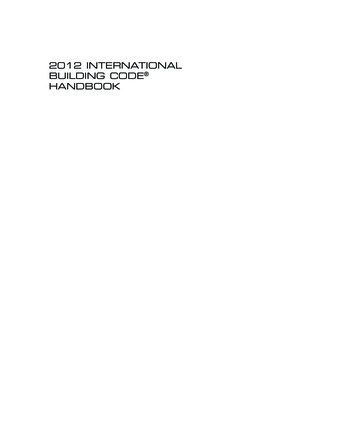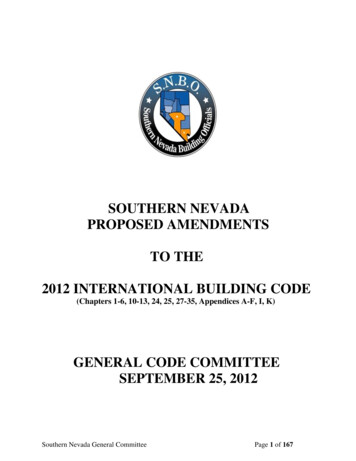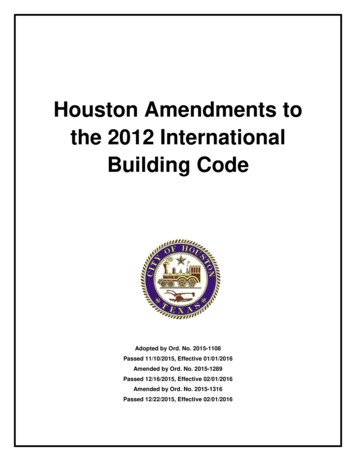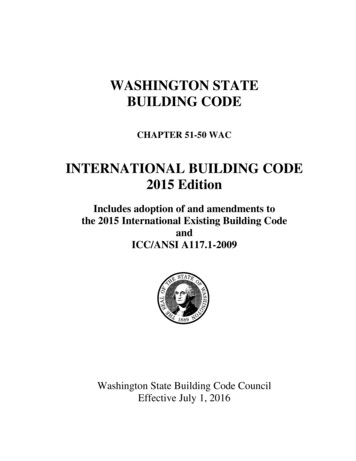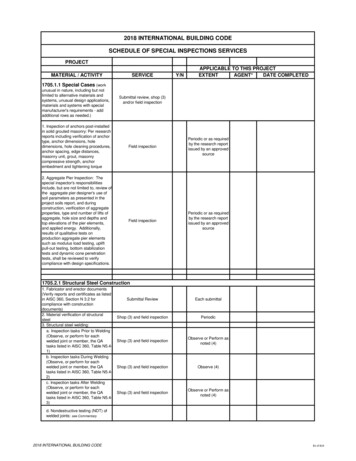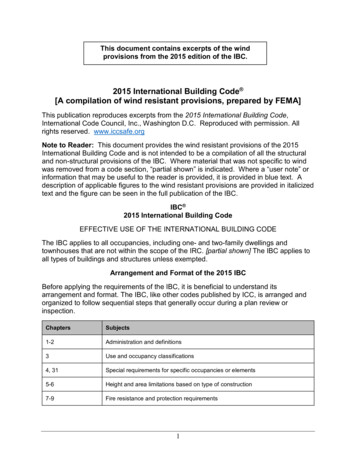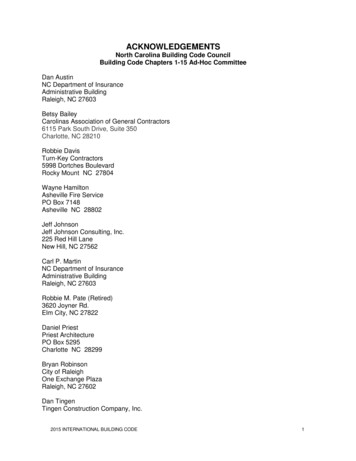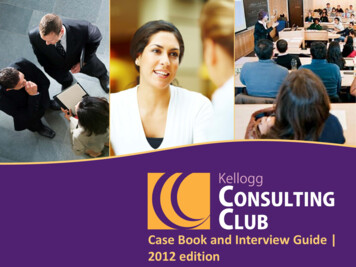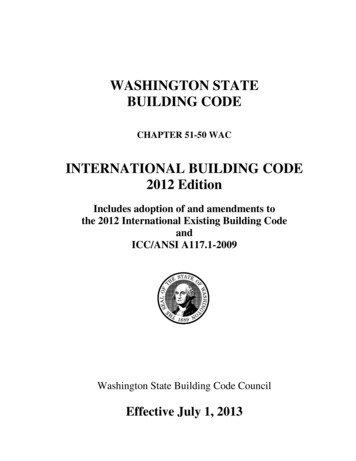
Transcription
WASHINGTON STATEBUILDING CODECHAPTER 51-50 WACINTERNATIONAL BUILDING CODE2012 EditionIncludes adoption of and amendments tothe 2012 International Existing Building CodeandICC/ANSI A117.1-2009Washington State Building Code CouncilEffective July 1, 2013
Copies of the State Building Codes andcomplete copies of the 2012 International Residential Codeas published by the International Code Councilmay be obtained from:Washington Association of Building OfficialsPost Office Box 7310Olympia, Washington 98507-7310(360) 628-8669www.wabobookstore.orgor toll free in Washington State at (888) 664-9515First Edition TitledInternational Building CodeChapter 51-50 WACbased onWSR 13-04-067Effective July 1, 2013Second Printing, May 2013
PrefaceAuthority: The International Building Code (Chapter 51-50 WAC) is adopted by the Washington State Building Code Councilpursuant to Chapters 19.27 and 70.92 RCW. These codes were first adopted by reference by the Washington State Legislature in1974. In 1985, the Legislature delegated the responsibility of adoption and amendment of these codes to the State Building CodeCouncil.Code Precedence: The State Building Code Act, Chapter 19.27 RCW, establishes the following order of precedence among thedocuments adopted as parts of the State Building Code:International Building Code, Standards and amendments -WAC 51-50;International Residential Code, Standards and amendments – WAC 51-51;International Mechanical Code, Standards and amendments - WAC 51-52;International Fire Code, Standards and amendments - WAC 51-54A;Uniform Plumbing Code, Standards and amendments - WAC 51-56Where there is a conflict between codes, an earlier named code takes precedence over a later named code. In the case of conflictbetween the duct insulation requirements of the International Mechanical Code and the duct insulation requirements of theEnergy Code, the Energy Code, or where applicable, a local jurisdiction's energy code, shall govern.Where, in any specific case, different sections of this Code specify different materials, methods of construction or otherrequirements, the most restrictive shall govern. Where there is conflict between a general requirement and a specific requirement,the specific requirement shall be applicable.Organization and Numbering: These rules are written to allow compatible use with the International Building Code. Allsections which are amended, deleted, or added are referenced.Enforcement: The State Building Code Act requires that each local jurisdiction enforce the State Building Code within itsjurisdiction. Any jurisdiction can contract with another jurisdiction or an inspection agency to provide the mandated enforcementactivities.Amendments to the State Building Code:The State Building Code Council has adopted review procedures and approval criteria for local amendments. Theseprocedures and criteria are found in Chapter 51-04 WAC. The Council has exempted from its review any amendmentsto the administrative provisions of the various codes.Forms for proposing statewide amendments to the State Building Code are available from the State Building CodeCouncil staff.A. Amendments of Statewide Application: On a yearly basis the State Building Code Council will considerproposals to amend the State Building Code. Unless directed by the State Legislature, federal mandates or courtorder, the Council will not enter formal rulemaking until 2015 as part of its consideration of adoption of the 2015series of codes.Proposals to amend the State Building Code shall be made on forms provided by the Building Code Council.Code Change Proposal Submittal Deadline: March 1st of each year.B. Local Amendments: Any jurisdiction may amend the State Building Code provided the amendments do not reducethe minimum performance standards of the codes. There are areas where local amendments are limited orprohibited:i
Prohibited Amendments: Residential provisions of the State Energy Code (WAC 51-11R and WAC 51-11C),Ventilation provisions in Section 408 of the Mechanical Code (WAC 51-52) and Section M1507 of the IRC (WAC 5151); any provision of the International Building Code or International Residential Code affecting accessibility; andstandards specifically adopted in Chapters 19.27 and 19.27A RCW cannot be amended by any local jurisdiction.Residential Amendments: Amendments by local jurisdictions which affect the construction of single familyand multi-family residential buildings must be reviewed and approved by the State Building Code Councilbefore such amendments can be enforced. The State Building Code Act provides the following definition:“Multi-family residential building” means common wall residential buildings that consist of fouror fewer units, that do not exceed two stories in height, that are less than 5,000 square feet in area,and that have a one-hour fire-resistive occupancy separation between units.Application forms for Council review of local amendments are available from the State Building Code Council Staff.Washington State Building Code CouncilPost Office Box 41449Olympia, Washington 98504-1449www.sbcc.wa.gov(360) 407-9280Fax (360) 586-5366e-mail: sbcc@ga.wa.govPrinting Format: This version of the rules is published as a series of insert or replacement pages. Each page providesinstructions for installing them in the model code book. Amendments to the model code which are new or revised fromthe previous edition of this code are indicated by a line in the margin next to the revised portions.Effective Date: These rules were adopted by the State Building Code Council on November 9, 2012. The rules areeffective throughout the state on July 1, 2013. (This version of the code is based on WAC 51-50 as published inWSR 13-04-067.Building Permit Fees: The activities of the State Building Code Council are supported by permit fees collected by eachcity and county. Section 19.27.085 of the State Building Code Act requires that a fee of 4.50 be imposed on eachbuilding permit issued by each city and county. In addition, a fee of 2.00 per unit shall be imposed for each dwellingunit after the first unit, on each building containing more than one residential unit. For the purpose of this fee, WAC365-110-035 defines building permits as any permit to construct, enlarge, alter, repair, move, improve, remove, convertor demolish any building or structure regulated by the Building Code. Exempt from the fee are plumbing, electrical,mechanical permits, permits issued to install a mobile/manufactured home, commercial coach or factory built structure,or permits issued pursuant to the International Fire Code.Each city and county shall remit moneys collected to the state treasury quarterly. No remittance is required until aminimum of 50.00 has accumulated.These permit fees are the amounts current in January 2013. Such fees may be changed by the State Legislature.Opinions: Only at the request of a local enforcement official, the State Building Code Council may issueinterpretations/opinions of those provisions of the State Building Code created by the Council, or provisions of the modelcodes amended by the Council. Final interpretation authority for any specific permit resides with the local enforcementofficial.ii
Table of ContentsSectionWAC 51-50-001WAC 51-50-002WAC 51-50-003WAC 51-50-005WAC 51-50-007WAC 51-50-008WAC 51-50-009PageAuthority . APurpose . AInternational Building Code . AInternational Building Code Regulations for Barrier-free Accessibility . AExceptions . AImplementation . ARecyclable Materials and Solid Waste Storage . AChapter 1 AdministrationSection 108 – Temporary Structures and uses . 7Chapter 2 DefinitionsSection 202 – Definitions . 11Chapter 3 Use and Occupancy ClassificationSection 305 – Educational Group E . 42Section 308 – Institutional Group I . 48Section 310 – Residential Group R . 49Chapter 4 Special Detailed Requirements Based on Use and OccupancySection 403 – High-Rise Buildings . 59Section 407 – Group I-2 . 66Section 420 – Groups I-1, R-1, R-2, R-3 . 91Chapter 5 General Building Heights and AreasSection 506 – Building Area Modifications . 99Section 509 – Incidental Uses . 104Chapter 9 Special Detailed Requirements Based on Use and OccupancySection 903 – Automatic Sprinkler Systems .Section 907 – Fire Alarms and Detection Systems .Section 908 – Emergency Alarm Systems .Section 909 – Smoke Control Systems .Section 911 – Fire Command Center .205217226234235Chapter 10 Means of EgressSection 1007 – Accessible Means of Egress . 243Section 1008 – Doors, Gates and Turnstiles . 249Section 1009 – Stairways . 252Section 1010 – Ramps . 256Section 1018 – Corridors . 265Chapter 11 AccessibilitySection 1101 – General . 281Section 1106 – Parking and Passenger Loading Facilities . 284Section 1107 – Dwelling Units and Sleeping Units . 285iii
Chapter 12 Interior EnvironmentSection 1203 – Ventilation .Section 1204 – Temperature Control .Section 1208 – Interior Space Dimensions .Section 1210 – Surrounding Materials .295296297299Chapter 14 Exterior WallsSection 1403 – Performance Requirements . 303Chapter 17 Structural Tests and Special InspectionsSection 1705 – Required Verification and Inspection . 383Section 1710 – Preconstruction Load Tests . 391Chapter 19 ConcreteSection 1901 – General . 421Section 1903 – Specifications for Tests and Materials . 421Section 1904 – Durability Requirements . 421Section 1905 – Modifications to ACI 318 . 423Section 1908 – Anchorage to Concrete—Allowable Stress Design . 426Section 1909 – Anchorage to Concrete—Strength Design . 426Chapter 21 MasonrySection 2107 – Allowable Stress Design . 438Section 2111 – Masonry Fireplaces .
2012 Edition Includes adoption of and amendments to the 2012 International Existing Building Code and ICC/ANSI A117.1-2009 Washington State Building Code Council Effective July 1, 2013 . Copies of the State Building Codes and complete copies of the 2012 International Residential Code as published by the International Code Council may be obtained from: Washington Association of Building .

